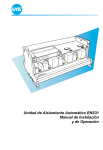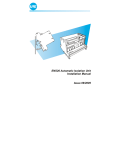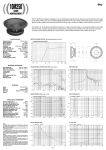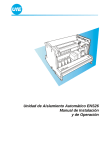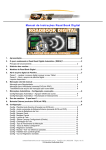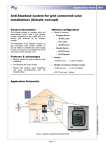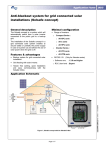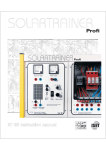Download ENS31 Automatic Isolation Unit Installation and Operating Manual
Transcript
ENS31 Automatic Isolation Unit Installation and Operating Manual UfE Umweltfreundliche Energieanlagen GmbH Joachim-Jungius-Straße 9 D - 18059 Rostock Tel.: Fax: E-mail: web: +49 3 81 / 405 97 05 +49 3 81 / 405 97 03 [email protected] www.ufegmbh.de Note If you have any queries and need to contact UfE GmbH, always have the serial number close to hand in order to make reference to it. We do not claim the documentation is free of errors and mistakes. Please inform UfE GmbH of any errors found in the documentation. © Copyright This operating manual is the copyright of UfE GmbH. This manual is intended for the operator and electrician. It contains instructions and information which must not be copied, distributed or transferred by technical data methods nor used for the purpose of competition, either as an entirety or as extracts, without the necessary authorisation. Contravention could lead to prosecution and obligation to pay damages. All rights reserved, particularly in the case of patent application or other registrations. We reserve the right to make technical modifications without notice. Note The ENS31 isolation unit and the measuring method are protected by patent. Page 2 of 32 Installation and Operating Manual ENS31 A.04 Declaration of Conformity We UfE Umweltfreundliche Energieanlagen GmbH Joachim-Jungius-Straße 9 D - 18059 Rostock declare in sole responsibility that the product Type: ENS31 Automatic Isolation Unit fulfils the applicable health and safety requirements in the EU Directives 89/336/EEC (Electromagnetic Compatibility EMC) and 73/23/EEC (low voltage guidelines) and the law reorganising the safety of technical apparatus and consumer products (law on equipment and product safety), as well as the requirements stipulated in other applicable, harmonised European Norms. In addition, the following directive is also fulfilled: 89/391/EEC (employee safety and health protection) Klaus-Wilhelm Köln Manager A.04 Installation and Operating Manual ENS31 Page 3 of 32 Table of Contents 1 Safety.................................................................................................................6 1.1 1.2 1.3 1.4 1.5 1.6 1.7 1.8 1.9 2 Connections and Indicators ..........................................................................12 2.1 2.2 3 Principles of functioning........................................................20 Function Test..................................................................................................21 6.1 6.2 7 Basic configuration ...............................................................17 Demands of the switching elements.....................................17 Circuitry ................................................................................18 Disconnection .......................................................................19 System Description........................................................................................20 5.1 6 Transport and unpacking......................................................14 Conditions for installation .....................................................14 Preparing the electrical/meter cabinet ..................................15 Mounting on the top hat rail ..................................................15 Removing from the top hat rail .............................................16 Electrical Connections...................................................................................17 4.1 4.2 4.3 4.4 5 Connections..........................................................................12 LCD display and LEDs .........................................................13 Mechanical Installation ..................................................................................14 3.1 3.2 3.3 3.4 3.5 4 General information ................................................................6 Safety symbols used in this operating manual .......................6 Obligations..............................................................................7 1.3.1. Obligations of the proprietor ....................................7 1.3.2. Obligation of personnel ...........................................7 Guarantee and liability............................................................8 Accident prevention regulations .............................................9 Intended use...........................................................................9 1.6.1 Exclusive purpose ...................................................9 1.6.2 Observe information and regulations ......................9 Installation and connection ...................................................10 Operation..............................................................................10 Rating plate and CE symbol .................................................11 Switching the system on.......................................................21 Indicators during operation ...................................................21 Operation ........................................................................................................22 7.1 Page 4 of 32 Switching the system on.......................................................22 Installation and Operating Manual ENS31 A.04 Table of Contents 7.2 7.3 7.4 8 LED indicators during the power-on routine .........................23 LCD displays during operation..............................................23 Switching the system off .......................................................25 Troubleshooting .............................................................................................26 8.1 8.2 General information ..............................................................26 Error indications in the LCD..................................................26 8.2.1 Error status for voltage ..........................................26 8.2.2 Error status for frequency ......................................26 8.2.3 Error status for phase angle ..................................27 8.2.4 Error status for impedance ....................................27 8.2.5 Faults in the ENS 31 isolation unit.........................27 8.2.6 Error texts for mains power fluctuations ................28 8.2.7 Hardware Errors ENS31 ........................................29 8.2.8 Error indication through LEDs ...............................30 9 Technical Data ................................................................................................31 10 Certificate of Non-Objection..........................................................................32 A.04 Installation and Operating Manual ENS31 Page 5 of 32 Chapter 1 Safety 1 1.1 Safety General information This chapter contains information on safety and rules of conduct. It is essential to observe the information and rules so that any residual risks represented by the product do not lead to a fault or an accident. The device must be connected to the local power supply. Therefore, all the normal risks involved in the use of electrical power are present here, too. 1.2 Safety symbols used in this operating manual The following symbols are used at the relevant points throughout this manual. Pay strict attention to the information provided in these sections and proceed with the utmost care. Meaning of the safety symbols: Danger This symbol indicates the risk of fatal or personal injury if certain rules of conduct are disregarded. When this symbol appears in the operating manual, take all the necessary safety precautions. Attention This symbol indicates the risk of property damage as well as financial and legal disadvantages (e.g. loss of rights to claims under the terms of guarantee, liability, etc.). Note This symbol indicates important information on working efficiently, economically and ecologically. Page 6 of 32 Installation and Operating Manual ENS31 A.04 Chapter 1 Safety 1.3 1.3.1. Obligations Obligations of the proprietor The proprietor is obliged only to allow suitably trained personnel to work with the ENS31 isolation unit who • are familiar with the basic regulations on safety and accident prevention • have read the operating manual, the chapter on safety and the safety symbols, have understood them and confirmed this with their signature. The proprietor must always ensure the entire product documentation is at the disposal of operating personnel. Danger The proprietor bears the responsibility for safety. This responsibility cannot be delegated. 1.3.2. Obligation of personnel Personnel must: • be in possession of a license to connect electronic equipment to the public electricity supply, • always ensure for themselves that third-parties and the equipment are safe, • maintain the safety and connection regulations of the power supply provider, • have read and understood the operating instructions, the chapter on safety and warning labels, • observe the applicable regulations concerning industrial safety and accident prevention. Danger This concerns the safety of yourself and other persons in the vicinity of the ENS31 as well as safety when working with the mains electricity supply. A.04 Installation and Operating Manual ENS31 Page 7 of 32 Chapter 1 Safety 1.4 Guarantee and liability Our "General Terms of Sale and Delivery" apply. The proprietor has claim to these on conclusion of the contract at the latest. Rights to claims under the terms of guarantee and liability in respect of persons and property are considered void when they are the result of one or more of the following causes: • Unintended use of the ENS31, • Improper start up, operation and service of the ENS31, • Failure to observe information in the overall documentation in respect of – – – – • • • installation, connection starting up operation cleaning/servicing Unauthorised constructional modifications to the ENS31, Damage through overvoltage, overload, short circuit, mechanical interference, moisture, Case of catastrophe caused by foreign body or Act of God. Attention No modification may be carried out on the ENS31 without the approval of the manufacturer. Attention Never attempt to repair the device yourself. All rights to claims under the terms of guarantee are annulled in the case of tampering. Page 8 of 32 Installation and Operating Manual ENS31 A.04 Chapter 1 Safety 1.5 Accident prevention regulations Any faults which occur that affect safety must be eliminated immediately. The ENS31 may not be operated until the fault has been cleared. Danger Solar modules conduct electricity as soon as they are exposed to daylight. Observe this when laying and connecting the cables and take the necessary precautions. Danger It is forbidden to open the unit. The box can continue to conduct dangerous residual voltage some minutes after being switched off. 1.6 Intended use The ENS31 has been built according to state-of-the-art technology and accepted safety regulations. However, when the unit is used, there remains a risk of fatal and personal injury to the user and third-parties as well as impairment of the unit and other property damage. 1.6.1 Exclusive purpose The ENS31 is exclusively intended for monitoring voltage, frequency and impedance of the electricity network at the feeding point of a power generating system. On detecting over- and undervoltages, frequency deviation or impedance jumps, the ENS31 disconnects the feeding point from the public electricity supply by means of contactors. Any other use is considered unintended use. The manufacturer is not liable for any consequential damage in such cases. 1.6.2 Observe information and regulations Intended use also includes • observing all information provided in this operating manual and • maintaining the connection and installation conditions prescribed by the manufacturer. A.04 Installation and Operating Manual ENS31 Page 9 of 32 Chapter 1 Safety 1.7 Installation and connection For installation and connection of the ENS31 please observe chapters 2 to 5. Danger It is forbidden to open the unit. The unit can continue to conduct dangerous residual voltage some minutes after being switched off. 1.8 Operation Operation of the ENS31 is impermissible: • for monitoring tasks for which the unit is not designed, • when using accessories which have not been approved by the manufacturer, • when the proprietor has made constructional modifications. Functional faults must be analysed immediately. If necessary, the proprietor must request specialist assistance. The equipment may only be put into operation again when there is no doubt about its safety. The ENS31 is intended for operation at room temperatures between - 20 °C and + 40 °C (also refer to Chapter 9). Contact a suitably trained electrician or the manufacturer in the following cases: • connection cable is damaged, • liquids or foreign bodies have got inside the unit, • the unit has been exposed to water or rain, • the unit has fallen down or is mechanically damaged, • the unit behaves in a way indicating a fault (e.g. indicator on the LCD, constant switching). Page 10 of 32 Installation and Operating Manual ENS31 A.04 Chapter 1 Safety 1.9 Rating plate and CE symbol The manufacturer has provided the following information on the ENS31 at the positions indicated: A B A Serial number The manufacturer’s serial number for the ENS31 is provided at this point. B CE-symbol The CE symbol is located at the bottom right corner of the front side. Note Always make reference to the ENS31 serial number in the case of inquiries, orders and contracts. This simplifies communication with the manufacturer and prevents errors when processing requests. A.04 Installation and Operating Manual ENS31 Page 11 of 32 Chapter 2 Connections and Indicators 2 2.1 Connections and Indicators Connections The following connections are provided at the top edge of the ENS31: <RELAIS <KONTAKTE 1 2 3 4 <NETZ N L1 L2 L3 1 2 A B C A 4 connection terminals for contactor control, potential-free; designation from left to right: R1, R2, R3 and R4 B 2 connection terminals to connect positively driven auxiliary contacts; designation from left to right: K1 and K2 C 4 connection terminals to connect three phases and the neutral conductor; designation from left to right: N, L1, L2 and L3 Page 12 of 32 Installation and Operating Manual ENS31 A.04 Chapter 2 Connections and Indicators 2.2 LCD display and LEDs The following indicators are mounted on the front side of the ENS31: X XXXXX A B C D A LCD display The unit and mains power status are shown on a 2-line LC display. Each line can display 16 characters. B to D LEDs In addition to the LCD, the unit and mains power status are also indicated by three LEDs (red, green, yellow): B = LED display for phase 1 (L1) C = LED display for phase 2 (L2) D = LED display for phase 2 (L3). Note The meaning of the indicators is described in chapter 7 and chapter 8. A.04 Installation and Operating Manual ENS31 Page 13 of 32 Chapter 3 Mechanical Installation 3 3.1 Mechanical Installation Transport and unpacking When transporting the ENS31 isolation unit, pay attention that it is always protected against contact with dirt and damage through impacts and setting down too hard. Remove the ENS31 from the transport packaging and pull off the protective foil, if necessary. After transport and before installation, check that the ENS31 isolation unit is in a perfect condition. 3.2 Conditions for installation The ENS31 is intended for installation on a top hat rail in an electrical cabinet or in a meter cabinet. It cannot be installed anywhere. The cabinet must be sufficiently large to house the ENS31, providing the necessary contactors and protect the unit from moisture, dust, dirt and heat. If there is not enough space in the cabinets available, a separate electrical cabinet must be mounted to accommodate the ENS31 and contactors. Attention Never position the electrical cabinet containing the ENS31 above or in the vicinity of a heater. Ensure sufficient ventilation. The ENS31 should be mounted as near as possible to the mains power outlet and as far as possible from the electricity feeding source. Note These measures reduce the effect of voltage increase by the current source. Page 14 of 32 Installation and Operating Manual ENS31 A.04 Chapter 3 Mechanical Installation 3.3 Preparing the electrical/meter cabinet Determine the installation position of the ENS31 on the top hat rail. Saw a cut-out in the cabinet cover at the installation position of the ENS31 so that you can see the ENS31 and its indicators (LCD and LEDs) without opening the cabinet. The cut-out must have the following dimensions: 219 mm 74 mm X XXXXX 3.4 Mounting on the top hat rail Set the isolation unit with its top housing holder (A) on the top hat rail and turn it downwards against the top hat rail (B). Use a little force to press on the bottom housing section until the housing holder engages in the top hat rail. A B A.04 Installation and Operating Manual ENS31 Page 15 of 32 Chapter 3 Mechanical Installation 3.5 Removing from the top hat rail The ENS31 can be removed from the top hat rail. Insert the tip of a screwdriver in the grooves (A) in the clamps at the ends of the housing. Pull the clamps downwards (B). The ENS31 is released. Remove the ENS31 by turning it a little (C) away from the top hat rail. C A B Attention Never remove the ENS31 from the top hat rail using brute force. This could damage the housing holders. Page 16 of 32 Installation and Operating Manual ENS31 A.04 Chapter 4 Electrical Connections 4 4.1 Electrical Connections Basic configuration The switching elements of the automatic isolating device (e.g. contactors) are not enclosed with the unit and must be brought by the installation technician. The technician decides on the switching elements most suitable. Danger The installation technician must ensure that the power generator is only connected to the mains via the two switching elements assigned to the ENS. Risk of accident! The ENS31 must be protected by pre-fuses in the mains feed circuit (min. 6 A, max. 25 A). Observe the circuit diagram. 4.2 Demands of the switching elements Two contactors with positively driven auxiliary contacts are required for mains disconnection. The feedback contacts must be connected in the correct sequence (refer to circuit diagram). The contactors must be designed for the nominal output of the current inverter or the system at AC3. The decisive factor for dimensioning is the phase with the highest load. A.04 Installation and Operating Manual ENS31 Page 17 of 32 Chapter 4 Electrical Connections 4.3 Circuitry N 1 2 1 2 3 4 3 4 5 6 5 6 L1 L2 L3 MAINS FEEDER Check that the mains power lines and power feed lines are not conducting electricity. Switch the power generator (feeder), ENS31 and contactors as follows (note the turning direction): 21 -K10.1 22 21 -K10.2 22 -K10.1 -K10.2 A1 R1R2R3R4 RELAY A2 A1 * * *min. 6 A max. 25 A A2 K1 K2 CONTACTS N L1 L2 L3 MAINS UfE - ENS31 Note The additional pre-fuse (*) is only necessary if the direct mains power fuse protection exceeds 25 A. The terminals on the ENS31 are arranged as follows: relay contacts mains Page 18 of 32 Installation and Operating Manual ENS31 A.04 Chapter 4 Electrical Connections Attention The ground conductor should always bypass the unit. The neutral conductor MUST be connected to the ENS31 otherwise the unit may be damaged. If the ENS31 is switched on and off by means of a system control unit, the L1 connection of the ENS31 can be switched by means of a relay. Note When switching on via L1, the delay until the contactors are activated can be up to 30 seconds because the ENS31 must test the power feed conditions again. 4.4 Disconnection Switch off the power supply to the mains power lines and lines from the power generator (feeder). Wait until the isolation unit has removed all the residual voltages. Danger The isolation unit can still conduct dangerously high residual voltage some minutes after being switched off. Risk of accident! Disconnect the mains power lines, contactor lines and relay lines. Insulate bare contacts from mains power lines, contactor lines and relays (e.g. using insulation tape). The ENS31 can then be removed from the top hat rail (also refer to Chapter 3.5). A.04 Installation and Operating Manual ENS31 Page 19 of 32 Chapter 5 System Description 5 5.1 System Description Principles of functioning The automatic, three-phase ENS31 isolation unit is an automatic switch which is used to connect decentralised electricity generators to the public electricity supply. In the event of faults in the mains supply, the ENS31 interrupts the feeding of electricity into the mains to prevent an island effect. The following deviations are monitored: • overvoltage and undervoltage • frequency deviation • impedance jumps The isolation unit replaces an otherwise prescribed manual isolation unit to which the power supply authorities must have permanent access. Note Further information on the principles of functioning is available on our Internet site at www.ufegmbh.de. Page 20 of 32 Installation and Operating Manual ENS31 A.04 Chapter 6 Function Test 6 6.1 Function Test Switching the system on Switch the isolation unit on first and then the power generator (feeder). The ENS starts up automatically after switching on the mains supply. The following appears on the LCD display after a successful self-test and mains test: D 231 232 233 V Ok 50,00 120 240 When the voltage, frequency and mains impedance are in the permissible range for 20 seconds, the contactors are triggered and power feed in the public electricity supply begins. The mains power is then monitored. 6.2 Indicators during operation After switching on, the values for voltage, impedance and frequency are displayed alternately (refer to chapter 7). A.04 Installation and Operating Manual ENS31 Page 21 of 32 Chapter 7 Operation 7 7.1 Operation Switching the system on The LCD indicates the status of the power-on routine: D 231 232 233 V Ok 50,00 120 240 The first character indicates the status of the ENS. The following states can occur during the power-on routine: Indicator Meaning i Following a reset, the ENS31 is in its initialised state. w After initialisation, all the error bits are deleted and the system waits a fixed time. r The ENS31 is waiting for a return signal. ^ The ENS31 switches on after the waiting period. D The ENS31 is switched on, the mains power is within a F permissible range and power is fed. The mains power is I monitored constantly. The letters indicate: D = Setting for Germany, Austria and Switzerland, F = Setting for France, I = Setting for Italy. X The ENS31 has interrupted power feed. Page 22 of 32 Installation and Operating Manual ENS31 A.04 Chapter 7 Operation 7.2 LED indicators during the power-on routine LEDs are provided for each individual phase and light up as follows during the power-on routine: Indicator Meaning All LEDs light up to begin with. After approx. 1 sec., a running light is activated. The mains power is in order and the ENS31 switches it on. During operation, the yellow LED can flash or light up continually. 7.3 LCD displays during operation The LCD runs through the following display modes cyclically: First display Error status, mains voltages, power-on routines since last rest, mains frequency, phase angle and error messages. A B C D 231 232 233 V Ok 50,00 120 240 F E D Indicator A.04 Meaning A Country identification plus error status. Country identification letters signify the following: D = Setting for Germany, Austria and Switzerland, F = Setting for France, I = Setting for Italy. B Mains voltage of the individual phases plus error status. L1 = left, L2 = middle, L3 = right. C D Number of power-ons since the last reset. E F Mains frequency and error status. Phase angle plus error status. The phase angle L1-L3 is to the right, phase angle L1-L2 is to the left. Mains power status ok. Installation and Operating Manual ENS31 Page 23 of 32 Chapter 7 Operation Second display Data from the 10-minute average values. A Ua: 231 232 233V Ul: 252V B Indicator Meaning A 10-minute average value of voltages plus error status. L1 = left, L2 = middle, L3 = right. B Upper shutdown threshold for the 10-minute average value. Third to fifth display Impedances of the three phases and shutdown thresholds. A B C D Z1= 0,44 24P 97% -0,20 0,03 0,20 G Indicator A B C D E F G Page 24 of 32 F E Meaning Phase identification (L1, L2 or L3) and error status. Estimated value for absolute impedance of this phase. Number of measuring pulses per second. Own share of the ENS31 in the total measuring signal. Dynamic upper shutdown threshold for the impedance jump. Last established impedance jump. Dynamic lower shutdown threshold for the impedance jump. Installation and Operating Manual ENS31 A.04 Chapter 7 Operation Sixth display Last error which occurred, information is lost following ENS reset. A B C 1d ago 30 s 2 P2:ZToHi R= 9.20 E D Indicator Meaning A Time since last error (s = seconds, m = minutes, h = hours, d = days, w = weeks, a = years) B Duration of last error (s = seconds, m = minutes, h = hours, d = days, w = weeks, a = years) C D E Power-on routines since last reset. Error text (also refer to Chapter 8) Error value (in the example: the impedance of 9.2 ohm was too high on phase 2) If hardware or impedance errors occur, the bottom line of the first display contains an error text. Note The meaning of the error texts and error status displays are described in Chapter 8. Attention Check the functionality of the ENS31 regularly. If, for example, a red LED lights up constantly, the ENS31 may be defective and no power is fed in (also refer to Chapter 8). 7.4 Switching the system off The ENS31 cannot be switched off. The unit switches to an idling state if no voltage is supplied. It resumes its tasks as soon as sufficient power is available. A.04 Installation and Operating Manual ENS31 Page 25 of 32 Chapter 8 Troubleshooting 8 8.1 Troubleshooting General information In the case of repeated problems with the mains supply (e.g. frequent deactivation due to mains overvoltage or undervoltage), contact the public electricity supply authority and have the mains power quality checked at the feeding point. A frequent disconnection from the mains power supply can be observed particularly in rural areas and areas with strong power fluctuations due to the proximity of industrial plants. 8.2 8.2.1 Error indications in the LCD Error status for voltage LCD indication Cause ^250 Overvoltage v150 Undervoltage /280 Undervoltage in the case of fast shutdown Undervoltage in the _130 case of fast shutdown Overvoltage in 10M250 minute average value 8.2.2 Recommended action If the mains power fluctuations occur frequently, contact your public electricity supply authority. Error status for frequency LCD indication Cause ^50,90 Frequency is too high Frequency is too low v48,00 Frequency jump was j48,00 detected (RoCoF) Page 26 of 32 Recommended action If the mains power fluctuations occur frequently, contact your public electricity supply authority. Installation and Operating Manual ENS31 A.04 Chapter 8 Troubleshooting 8.2.3 Error status for phase angle LCD indication Cause !170 Phase angle deviates too far from setpoint. !240!120 8.2.4 Wrong direction of rotation of mains. Swap phases L1 and L2 at the connection terminals. Error status for impedance LCD indication Cause ^ 9,25 Impedance is implausibly too high. Impedance is v -0,99 implausibly too low (negative). Impedance jumps have n 0,33 been detected. p 0,44 8.2.5 Recommended action If the mains power fluctuations occur frequently, contact your public electricity supply authority. Recommended action If the mains power fluctuations occur frequently, contact your public electricity supply authority. Faults in the ENS 31 isolation unit In the event of errors, the following text appears in the bottom line of the first or sixth display: LCD indication HRD1Err### HRD2Err### HRD3Err### TMRErr### Cause A measuring error or hardware error has caused in the ENS31 has caused a shutdown. The 3 digits (###) are error codes for reference by the manufacture. If the error occurs only briefly, it is probably due to a measuring error. If the ENS31 does not switch on at all, it must be replaced. Note The ENS31 cannot be repaired on site. Please inform the specialist workshop that a replacement is required. A.04 Installation and Operating Manual ENS31 Page 27 of 32 Chapter 8 Troubleshooting 8.2.6 Error texts for mains power fluctuations In the event of a power fluctuation, one of the following texts appears in the bottom line of the first or sixth display: LCD indication P* : ZPJp dR= 1.20 P* : ZNJp dR=-1.20 P* : ZToHi R= 9.20 P* : ZToLo R=-0,99 P* : FToHi F=50.83 P* : FToLo F=46.83 P* : FrqJp dF=-600 P* : F Pha2 W=180° P* : F Pha2 W=200° P* : F Pha2 W=664° P* : UTHi Ua=260.0 An impedance jump has been detected. The impedance is too high or too low. The impedance is too high or too low. Shutdown following RoCoF, value in mHz/s Shutdown due to too great a phase angle deviation Phase L2/L3 inerchanged The mains voltage is too high, response time 10 minutes. P* : UToHi U=265.3 P* : UToLo U=130.4 The mains voltage is too high or too low, response time 200 ms. P* : UTHi Uf=310.0 P* : UTLo Uf=120.3 The mains voltage is too high or too low, response time 20 ms, fast shutdown to protect unit • Page 28 of 32 Meaning stands for 1, 2 or 3 and indicates the phase affected L1, L2 or L3 Installation and Operating Manual ENS31 A.04 Chapter 8 Troubleshooting 8.2.7 Hardware Errors ENS31 Wiring faults / Contactors HRD1 LCD indication Meaning HRD1 01 00 00 NC contact of contactor 1 is open bevor contactor 1 is activated. HRD1 02 00 00 NC contact of contactor 2 is open bevor contactor 2 is activated. HRD1 04 00 00 Contactor 1 activates even with missing enabling signal HRD1 08 00 00 NC contact of contactor 1 does not open even if contactor 1 is activated Cause NC contact not connected according to item 4.3. NC contact not connected according to item 4.3. Enabling defective / contactor incorrectly wired Contactor 1 does not operate / contactor incorrectly wired, NC contact not correctly connected, NC contact interchanged HRD1 40 00 00 Contactor 2 activates even with missing enabling signal Enabling defective / contactor incorrectly wired HRD1 80 00 00 NC contact of contactor 2 Contactor 2 does not operate / does not open even if contactor incorrectly wired, contactor 2 is activated NC contact not correctly connected, NC contact interchanged HRD2 LCD indication A.04 Meaning Cause HRD2 01 00 00 Contactor 1 deactivates with valid input signal Contactor 1 faulty HRD2 02 00 00 Contactor 2 deactivates with valid input signal, NC contact 2 opens with contactor 1 activated. Contactor 2 faulty, NC contact interchanged, one contactor controls both signal inputs. Installation and Operating Manual ENS31 Page 29 of 32 Chapter 8 Troubleshooting 8.2.8 Error indication through LEDs LED indication Cause Recommended action Frequency error Red lights up, green flashes Voltage error Red and green flash simultaneously Impedance error Red and green flash alternately Wait until the mains is switched on again. Contact the pubic electricity authority in the case of longer power failures. Measured value(s) Mains power is ok. outside the factory Green lights up with short tolerance interruptions ENS31 waiting for Mains power is ok. acknowledgement from inverse rectifier Green flashes rapidly Display of impedance jump threshold value: lights up briefly = 0.1 ohm lights up longer = 0.5 ohm. or short, short, long = 0.1 + 0.1 + 0.5 = 0.7 Ohm LED continually on: threshold is set to 1 ohm or more. Measuring error or If the LED lights up ENS31 has failed longer than 1 minute with mains available, the Red lights up ENS31 is defective. Have the ENS31 replaced by a specialist workshop. Page 30 of 32 Installation and Operating Manual ENS31 A.04 Chapter 9 Technical Data 9 Technical Data Switched power (max.) Dependent on the contactors assigned Own consumption Housing 3.5 W Overall dimensions (W x H x D) 220 mm x 111 mm x 80 mm Cut-out dimensions (W x H) 220 mm x 73 mm Plastic, suitable for assembly on the top hat rail - 20 °C to + 40 °C, 10 to 90 % relative humidity, noncondensating According to max. switching Nominal current of power feeder power of the contactors The unit disconnects the mains under the following defined conditions (complying with standard DIN VDE 0126): > 300 V (response time 0.02 s) Overvoltage (fast shutdown) > 264 V (response time 0.2 s) Overvoltage 230 V + 10% over 10 minutes Overvoltage (average) < 130 V (response time 0.02 s) Undervoltage (fast shutdown) < 185 V (response time 0.2 s) Undervoltage + 0,2 Hz / -2,5 Hz Frequency deviation (response time 0.2 s) > 0.5 Ohm (response time 0.5 s) Impedance jump detection Ambient conditions A.04 Installation and Operating Manual ENS31 Page 31 of 32

































